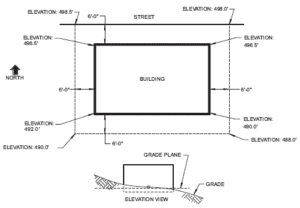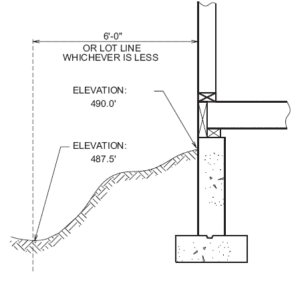Grade Plane. What is it and why it is important?

The phrase grade plane is mentioned repeatedly throughout the codes, but what is and why is important to understand this term? What does it have to do with the fire sprinkler industry?
Grade Plane and Fire Protection
Grade plane can and does affect a lot of different requirements throughout the entirety of the codes, especially fire sprinkler system requirements. Grade plane affects how many control areas are allowed in hazard material storage, limits the height of airport traffic control towers, height of covered and open mall buildings, and others. Some of the most important requirements that grade plane affects are the sprinkler system requirements found in Chapter 9 of the IBC and Chapter 1 of the IRC.
 Sprinkler systems are required in F-1 fire areas more than three stories above grade plane. (903.2.4 #2) Group M fire areas located more than three stories above grade plane. (903.2.7 #2) The same goes for S-1 fire areas. (903.2.9 #2).
Sprinkler systems are required in F-1 fire areas more than three stories above grade plane. (903.2.4 #2) Group M fire areas located more than three stories above grade plane. (903.2.7 #2) The same goes for S-1 fire areas. (903.2.9 #2).
There are even more requirements as one continues to read Chapter 9. One of the more important requirements of grade plane is found in Chapter 1 of the IRC. Grade plane governs the entire scope of the International Residential Code. It affects what type of sprinkler system are installed in such structures. Therefore, it is vital to understand the definition of grade plane and how to measure for the location of grade plane for any given structure.
So, what is it? Grade plane is defined as, “A reference plane representing the average of finished ground level adjoining the building at exterior walls. Where the finished ground level slopes away from the exterior walls, the reference plane shall be established by the lowest points within the area between the building and the lot line or, where the lot line is more than 6 feet from the building, between the building and a point 6 feet from the building.”
Grade Plane Calculation
 The definition indicates that the grade plane is a reference plane representing the average of the finished ground level adjoining the building at its exterior walls. The method for grade plane calculation can vary based on the site condition. Situations may arise where the ground adjacent to the building slopes away from the building due to site or landscaping considerations.
The definition indicates that the grade plane is a reference plane representing the average of the finished ground level adjoining the building at its exterior walls. The method for grade plane calculation can vary based on the site condition. Situations may arise where the ground adjacent to the building slopes away from the building due to site or landscaping considerations.
In this case, the lowest finished ground level at any point between the building’s exterior wall and a point 6 feet from the building (or the lot line, if closer than 6 feet) comes under consideration. Where the slope away from the building is minimal (typically provided only to drain water away from the exterior wall), the elevation at the exterior wall provides an adequate reference point.
These points are used to determine the elevation of the grade plane. In the example provided we can easily calculate the grade plane. (498.5+498+490+ 488=1,974.5’/4=493.6’ Grade plane = 493.6’) Where the slope is generally consistent as it passes across the building site, it may only require the averaging of a few points along the exterior wall of a rectangular-shaped building. Where the slope is inconsistent or retaining walls are utilized, or where the building footprint is complex, the determination of grade plane can be more complicated. In such cases, a more exact method for calculating the grade plane must be utilized.
In addition, where fire walls are present, the elevation points should be taken at the intersections of the fire wall and the exterior walls. It is important to note that for the vast majority of buildings, it is not necessary to precisely calculate the grade plane. In such buildings, a general approximation of grade plane is enough to appropriately apply the code.
A detailed calculation is only necessary in those limited situations where it is not obvious how the building is to be viewed in relationship to the surrounding ground level. Being able to understand the term and properly calculate the location of the grade planes can make the difference at to whether not fire protection is required as well as affect what type of system is required.
Want to Learn More About Grade Plane and Fire Protection? The National Fire Sprinkler Association is Your Resource!
Members and employees of NFSA work very closely in the codes and standards development process. Our team of experts stay on the cutting edge of fire protection issues by participating in over 250 codes and standards development committees. If you have an interest in NFSA’s mission to protect lives and property through the widespread acceptance of the fire sprinkler concept, or you simply want to get more involved in the codes and standards process with NFSA, please visit our membership page.
